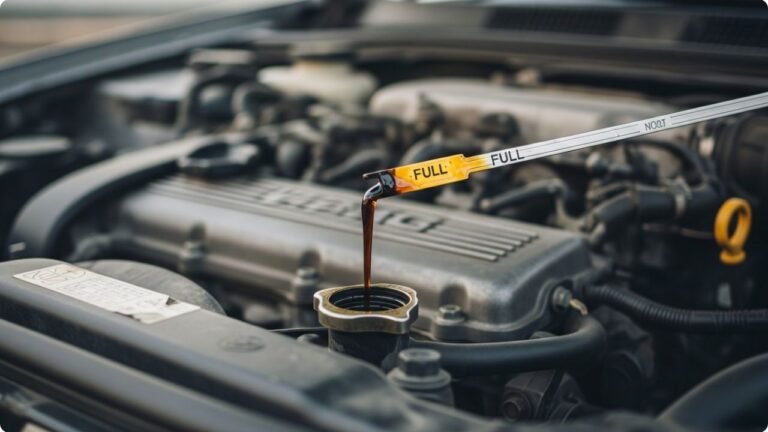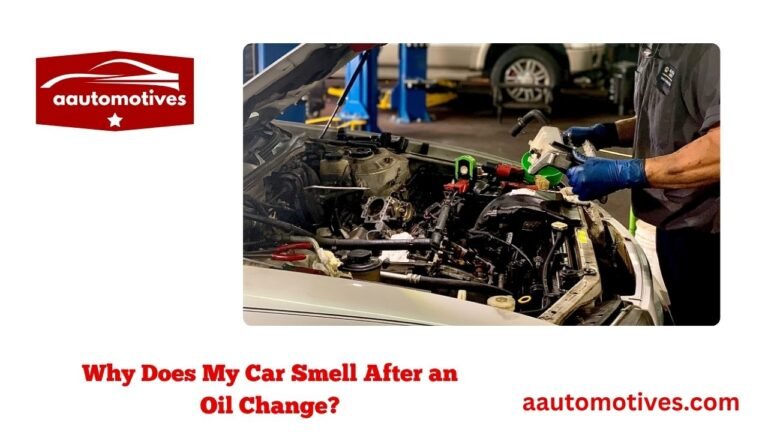I Put Oil in My Car, Now It’s Smoking: What Went Wrong?

You’re doing what every responsible driver should—checking your engine oil. You notice the dipstick shows low oil, so you top it up. All seems well… until you start the engine and smoke begins to billow from under the hood or out the exhaust. Panic sets in. You ask yourself, “I put oil in my car, now it’s smoking—what did I do wrong?”
Don’t worry. You’re not the first to experience this. It’s more common than you’d think, and it doesn’t always mean major damage. Sometimes it’s just a messy spill. Other times, it’s a warning sign your car is begging you not to ignore. In this article, we’ll explore all the possible causes, what to check, how to fix it, and how to avoid the smoke show in the future.
Why Is My Car Smoking After I Added Oil?
When someone says, “I put oil in my car, now it’s smoking,” there are a few immediate possibilities. Let’s break it down:
-
Too much oil was added
-
Oil spilled on hot engine parts
-
A deeper engine issue existed before adding oil
-
Oil leaked due to a damaged seal or gasket
-
Wrong type of oil was used
Each of these can cause smoking, but they vary in seriousness. Sometimes the smoke clears on its own. Other times, it’s a red flag.
Smoke from the Hood vs. Smoke from the Exhaust
One of the first things you need to observe is where the smoke is coming from. That gives you major clues.
| Smoke Location | Common Cause | Urgency Level |
|---|---|---|
| Hood (engine bay) | Spilled oil burning off engine parts | Low to Medium |
| Tailpipe (exhaust) | Oil in combustion chamber or wrong oil | Medium to High |
| Both | Overfilled oil causing internal issues | High |
Under-the-Hood Smoke
If you see white or bluish smoke coming from under the hood, it could just be that you spilled a bit of oil on the hot engine. This burns off when the engine heats up. It smells bad and looks dramatic, but it’s not always dangerous.
Smoke from the Tailpipe
This is more serious. Blue smoke from the tailpipe usually means oil is burning inside the engine. It may have gotten past worn-out valve seals, piston rings, or it could be overfilled and pushed past the gaskets. Either way, you need to check the oil level and get your engine inspected.
Overfilling Oil: The Most Common Mistake
One of the main causes behind the phrase, “I put oil in my car, now it’s smoking,” is overfilling. It’s surprisingly easy to do—especially when you’re topping off without knowing how much the car actually needs.
When you add too much oil, it can:
-
Create foam as the crankshaft churns the excess oil
-
Push oil into places it shouldn’t be (like spark plugs or exhaust)
-
Cause pressure to blow out seals or gaskets
Symptoms of Overfilled Engine Oil
-
Blue or white smoke from the exhaust
-
Engine misfire or rough idle
-
Oil leaks from under the car
-
Smell of burning oil
-
Check Engine Light may turn on
Overfilling can also clog your catalytic converter over time, leading to expensive repairs. If you suspect you’ve overfilled, check the dipstick. If the oil line is above the full mark, drain the excess immediately.
Spilled Oil on Engine: A Messy but Minor Issue
Sometimes, the smoke is from oil you accidentally spilled while pouring. A simple slip of the hand can cause oil to land on the exhaust manifold, which gets extremely hot. As soon as the engine warms up, that oil burns and creates white smoke.
It’s nothing to panic about, but it will continue smoking until it all burns off. You can wipe off excess with a rag or use a degreaser if you notice a puddle.
What You Can Do:
-
Use a flashlight to inspect where oil may have dripped
-
Wipe off visible oil on engine parts
-
Run the engine for a few minutes to let it burn off safely
-
Avoid driving long distances until the smoke stops
If the smell and smoke persist beyond 10–15 minutes of running, there may be a deeper problem.
Wrong Oil Type: Yes, That Matters!
Many drivers underestimate how critical oil type is. Your engine is designed to use a specific viscosity, like 5W-30 or 10W-40. If you accidentally use the wrong oil—or mix synthetic with conventional in incompatible systems—it can lead to performance issues and smoking.
How the Wrong Oil Can Lead to Smoke:
-
Too thick = improper flow, overheating
-
Too thin = leaks and low protection
-
Additives burn differently and may smoke
Always check your owner’s manual or oil cap for the recommended type. If you used the wrong oil and now you’re seeing smoke, a complete oil change may be needed.
Blown Seals or Gaskets: Oil Leaks You Didn’t See Coming
Adding oil to an engine with worn-out seals or gaskets can lead to a surprise. If there’s internal damage, oil may leak into the cylinder, mix with fuel, and burn—causing blue smoke from the exhaust. Sometimes, the extra pressure from fresh oil exposes a failing valve cover gasket or head gasket.
If you find yourself saying, “I put oil in my car, now it’s smoking and I smell something burnt,” this could be your problem.
Signs to Watch Out For:
-
Persistent smoke even after cleanup
-
Oil leaking visibly under the engine
-
Poor performance or misfiring
-
Unusual smells or overheating
In these cases, it’s best to have a mechanic run a pressure test or visual inspection.
Quick Checklist: What to Do Immediately
If your car starts smoking after adding oil, here are quick actions you can take:
-
Turn off the engine and let it cool
-
Check the dipstick for oil level
-
Look under the car for leaks
-
Inspect the engine for spilled oil
-
Observe where the smoke is coming from
-
Don’t drive far—get it checked if unsure
If you’re stuck on the road, pull over safely and call for help. Don’t risk your engine for a guess.
Common Emotions: You’re Not Alone
It’s easy to feel embarrassed or anxious when something like this happens. Maybe you’re thinking:
-
“Did I ruin my engine?”
-
“Is this going to cost thousands?”
-
“Why did this happen after doing the right thing?”
Breathe. Many people face this exact situation, especially when they’re learning basic car care. You’re taking responsibility by checking and maintaining your oil—that’s a good thing. The smoke is your car’s way of asking for a little attention. Listen to it, and you’ll likely be fine.
Real-World Story: A Friend’s Oil Spill Scare
My friend Zakir, a new driver in Dhaka, topped off his oil during a hot afternoon. Within minutes of restarting the car, a thick cloud of white smoke started rising from the bonnet. Panicked, he thought he’d “blown the engine.” Turns out, he’d spilled oil on the exhaust shield. A quick wipe-down and some fresh air later, the smoke cleared.
Moral of the story? Not all smoke means disaster. Sometimes, it’s just the engine saying, “Clean me up!”
Step-by-Step: How to Fix the Smoking Problem
If your car starts smoking after adding oil, the fix will depend on the cause. Here’s a breakdown of the most common scenarios and how to address them.
1. If You Overfilled the Oil
Solution: You’ll need to drain the excess oil. This can be done by:
-
Using a manual fluid extractor (through the dipstick tube)
-
Loosening the oil drain plug slightly to let a small amount out
-
Getting an oil change to reset the oil level properly
Important: Never leave your oil level above the “MAX” mark on the dipstick. Over time, it can damage seals, gaskets, and the catalytic converter.
2. If Oil Was Spilled on the Engine
Solution:
-
Use a clean cloth or rag to carefully wipe off any visible oil
-
If it’s hard to reach, use an engine-safe degreaser
-
Let the engine run in a well-ventilated space so the rest can burn off safely
This smoke should stop after 10–20 minutes. If it continues, recheck for leaks or other issues.
3. If You Used the Wrong Oil Type
Solution: Perform a complete oil change. That includes:
-
Draining all the oil
-
Replacing the oil filter
-
Refilling with the correct viscosity and grade recommended by your car’s manual
Avoid mixing brands and types unless the oil specifically states it is compatible.
4. If You Have a Leak or Internal Damage
Solution:
-
Take your car to a qualified mechanic
-
Ask for a compression test, leak-down test, or visual inspection
-
They may recommend replacing a valve cover gasket, head gasket, or piston rings if internal damage is confirmed
This is not a DIY job unless you have mechanical experience.
How to Avoid This Issue in the Future
Knowing what went wrong is half the battle. Here are some tips to prevent smoke after adding oil next time:
-
Always check oil level before adding any
-
Use a funnel to prevent spills
-
Add oil slowly, in small amounts
-
Wait a few minutes, then recheck with the dipstick
-
Never guess the oil type—verify with your manual
-
Watch for oil leaks around the engine bay
Pro Tip: Keep a small notebook or app log of your oil changes and top-ups. It helps track how much oil your car consumes over time.
The Real Cost of Ignoring Smoking After Adding Oil
If you notice smoke and do nothing, you’re not just risking embarrassment—you’re risking serious engine damage. Here’s what ignoring it can lead to:
| Problem | Possible Consequence | Estimated Repair Cost |
|---|---|---|
| Overfilled oil | Blown gaskets, catalytic converter damage | $500–$2,000+ |
| Internal leak | Engine misfire, valve damage | $800–$3,500 |
| Ignored oil spill | Persistent smoke, fire hazard | $100–$300 (cleaning) |
| Wrong oil used | Accelerated wear, poor performance | $70–$150 (oil change) |
Preventing damage early is far cheaper than fixing it later. Think of your engine like a friend—it tells you something’s wrong. All you have to do is listen.
FAQs: You Asked, We Answered
1. Why is my car smoking after I changed the oil?
If you recently changed the oil and it’s smoking, it could be due to residual oil left on engine parts or an overfill issue. Check the oil level and inspect for spills.
2. Is it safe to drive a smoking car?
No. If you see consistent smoke, especially from the exhaust, it’s best to stop driving immediately. Continuing to drive can make things worse, especially if oil is leaking internally.
3. How much oil is too much?
Even half a quart too much can be harmful. Always keep the oil level between the MIN and MAX lines on the dipstick. Anything above that should be removed.
4. Can too much oil ruin an engine?
Yes. Too much oil can cause foaming, poor lubrication, and pressure build-up, which can damage seals, gaskets, and bearings. Long-term damage could require a full engine rebuild.
5. Why is white smoke coming from the hood after adding oil?
This is usually from oil spilling onto a hot engine part like the exhaust manifold. It’s generally harmless and should clear after a short drive. If it continues, get it checked.
6. Can I use a different oil brand than last time?
Yes, but it’s best to use the same viscosity and API rating. Mixing synthetic with conventional can be okay if the oils are labeled as compatible, but it’s safer to be consistent.
7. Should I worry if the smoke smells sweet or like burning rubber?
Yes. A sweet smell might suggest coolant leak, while burning rubber often indicates oil hitting belts or wires. These could be signs of deeper issues and should be checked.
8. What if I added oil but now my car runs worse?
If your car is idling rough, stalling, or losing power after adding oil, you may have:
-
Overfilled the engine
-
Used the wrong oil
-
Leaked oil onto spark plugs
Get it inspected immediately.
Final Thoughts: You’re Learning, and That’s What Counts
We all start somewhere. Whether you’re new to car maintenance or just trying to do things right, making a mistake like “I put oil in my car, now it’s smoking” doesn’t make you a bad driver. It makes you human.
The important thing is how you respond. You searched for answers, you’re learning, and you’re taking action—and that’s something to be proud of. The more you understand your car, the more confident you become behind the wheel.
So next time you pop the hood, take a deep breath. You’ve got this.






